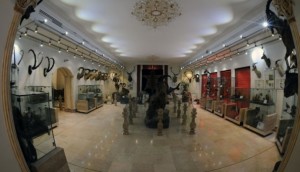 Zistboom:�Iran Wildlife and Nature Museum is located in Darabad, northeastern Tehran, and also known as Darabad Museum.
Zistboom:�Iran Wildlife and Nature Museum is located in Darabad, northeastern Tehran, and also known as Darabad Museum.Darabad is a former village on the slopes of the Alborz Mountain Range to the northeast of Tehran, which has become part of Greater Tehran as a result of rapid expansion of the metropolis.
Many people use Darabad as the starting point for mountaineering on the southern slopes of Alborz, especially in summer. It is also the location of Mahak Hospital for children with cancer.
The museum was inaugurated by Dr. Hedayatollah Tajbaksh (the well-known taxidermist) with the help of Tehran Municipality and Department of Environment in 1993.
It seeks to familiarize citizens with natural heritage and protection of environment and wildlife.
The museum joined the International Council of Museums (ICOM) in 1997. In the same year, it launched the online magazine "Nature and Wildlife of Iran�.
It actively participated in the gatherings of ICOM in Spain and IUCN (International Union for Conservation of Nature and Natural Resources) in North Africa.
Iranian and Afghani artists built a dinosaur statue�belonging to Jurassic era�at entrance of the museum in 2001, the dinosaur�s fossil had been found in Kerman, southern Iran.
Built in an area of 12,000 square meters, the museum has two floors and various sections.
North America Hall
The first hall pertains to the wildlife of North America such as moose, which is the largest extant species in the deer family.
Northern Iran Hall
The other hall pertains to animals of northern Iran. For example, Mazandaran tiger, which has become extinct, was displayed. It also exhibits animals such as maral (Caspian red deer), buck and beluga sturgeon.
South and Central Iran Hall
This hall is home to animals belonging to central and southern parts of Iran such as Iranian zebra, leopard, cheetah and tashi (the largest Iranian rodent).
Fish and Reptiles Hall
Visitors can see living creatures such as fish living in fresh and saline water, Amazon River and Persian Gulf.
The diverse colors of these species, along with their beautiful movements in water, create a scenic landscape.
There are two species, including leatherback turtle and hawksbill turtle, which are facing extinction.
The hall displays reptiles such as spiny-tailed lizard and desert monitor lizard.
Geology Hall
The top floor pertains to geology where fossils, stones and mineral ores have been displayed. There are also dinosaur footprints. In the paleontology section, the first living objects on earth and fossils with scientific classifications have been displayed.
There are cones such as Ivory Cone (Conus eburneus), butterfly cone (Conus pulcher), fluted giant clam, Tridacna squamosa and Pecten byramensis.
Major fossils on show include Nautilida, Ammonitida, Marattiales, Monobathrida, Phacopida and Fenestrata.
Insects Hall
There are glass displays for exhibiting butterflies and insects. They include butterflies of Australia and East Asia, such as Morphidae and Pandoriana Pandora.
Also, butterflies of Iran such as Papilo Demoleus, Pieris Brassica and Danaus Chrysippus are exhibited.
Taxidermy Hall
In the Taxidermy Hall, there are workshops for watching and learning different techniques of preserving natural animals.
Also a diorama, a three-dimensional, full-size or miniature model of habitats of wildlife�enclosed in a glass showcase�has been placed here.
Models of stuffed fish and crustaceans have been put on display.
Other halls
While the African Hall has displayed the bovidae family and African lion, the Pond and Birds Hall exhibits birds such as ducks and parrots in a pond.
Programs
Darabad Museum has published many environmental books for children and adolescents. It holds training courses for schoolchildren in cooperation with NGOs in summer.
The museum annually holds Child and Nature Festival to commemorate World�s Children Day for one week. It also organizes other programs to familiarize children with environmental issues.
Darabad Museum offers free entry during the International Museum Day.
It holds ecotourism tours to increase public awareness about environmental protection.
The museum held the International Caricature Festival on nature with the participation of famous cartoonists.
Facilities
The museum library has over 15,000 books in specialized environmental fields. It is considered a top library of botany, zoology and geology in Tehran. It is the first public library to provide online access to visitors since 1997.
The amphitheater hall, which offers seating for 70 visitors, screens environmental films, holds training courses, launches seminars and organizes concerts.
The outdoor cinema operates during summer.
The museum also has a traditional teahouse overlooking the city of Tehran. There is a veterinary clinic near the museum building, which treats pets.
It also sells domestic animals such as birds, squirrels, rabbits, dogs, cats, turtles and fish.
By Zistboom�
The Iran Project is not responsible for the content of quoted articles.











